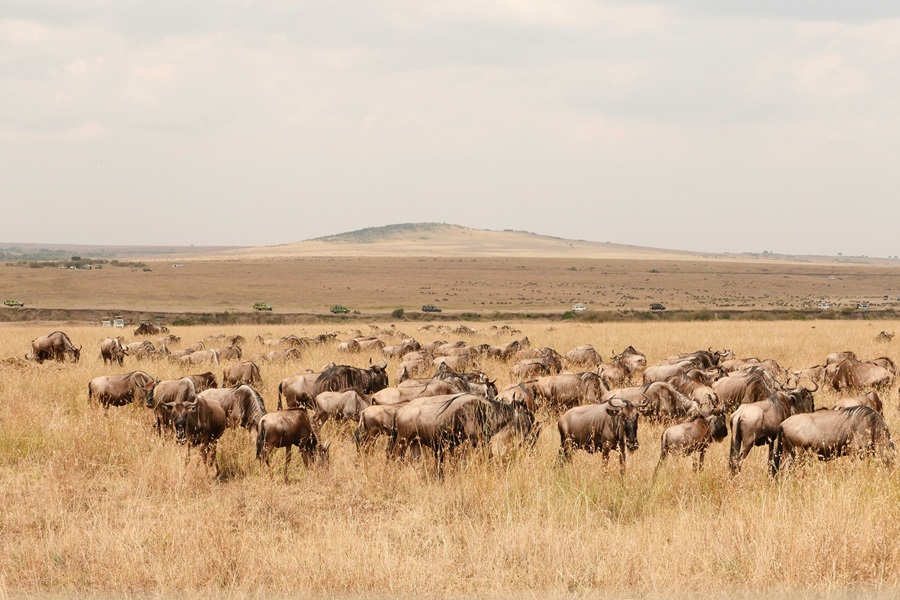The Great Wildebeest Migration in Serengeti National Park is one of the most extraordinary wildlife events on Earth. Every year, over 1.5 million wildebeest, joined by hundreds of thousands of zebras and gazelles, traverse the vast plains of northern Tanzania and Kenya in search of fresh grazing land and water. This natural spectacle—driven by instinct and survival—is a continuous journey through the Serengeti ecosystem that captures the true essence of Africa’s wilderness.
The Great Migration is a year-round, circular movement of wildebeest and their companions across the Serengeti–Mara ecosystem. Guided by seasonal rains, the herds move from the southern plains of the Serengeti to the northern reaches near the Mara River, covering roughly 1,800 miles (2,900 km) annually. Along the way, they face predators, raging rivers, and the harsh realities of the wild—making this not just a migration, but a story of endurance and life itself. Learn more about Serengeti history and wildlife.
The migration is not a single event but a cycle that unfolds throughout the year, offering unique experiences depending on when and where you visit the Serengeti. Here’s a guide to what happens each season—perfect for planning your best time to visit Serengeti:
Grumeti River crossings: crocodile drama
First CrossingsBetween December and March, the herds gather on the short-grass plains of the Southern Serengeti and Ndutu area to give birth. Around 400,000 calves are born within a few weeks—an incredible sight that attracts predators like lions, hyenas, and cheetahs. This is one of the best times to visit for wildlife photography, dramatic predator-prey interactions, and stunning open landscapes filled with new life. Stay at luxury lodges or campsites nearby.
As the long rains begin, the herds start moving northwest toward the Western Corridor and the Grumeti River. The landscape turns lush and green, creating a beautiful contrast against the dark clouds and vibrant wildlife. Though this is a quieter season for tourism, it’s perfect for travelers who prefer solitude and a more intimate safari experience. Ideal for camping safaris.
In early winter, the migration reaches the Western Serengeti, where the wildebeest face their first major challenge: crossing the crocodile-filled Grumeti River. These crossings are intense and action-packed, offering some of the most dramatic wildlife scenes in Africa. It’s also a great time for game drives and walking safaris in private reserves bordering the Serengeti. Add a hot air balloon safari for aerial views.
From July to October, the herds arrive in the Northern Serengeti, near the Mara River. This is the most famous phase of the Great Migration, where thousands of wildebeest plunge into turbulent waters while crocodiles lie in wait. The Mara River crossings are unpredictable, thrilling, and unforgettable—making this period the peak migration safari season.
The northern plains, around Kogatende and Lamai, offer ideal viewing spots with fewer crowds than Kenya’s Maasai Mara. This is also when the Serengeti is at its most photogenic, with golden grasslands, dramatic light, and abundant wildlife. Book private safaris or group joining tours.
With the arrival of the short rains, the herds begin their long journey southward once again, passing through the Central Serengeti. The cycle continues as they return to the fertile calving grounds of Ndutu. This transitional period offers diverse game viewing opportunities, with predators following the herds and migratory birds filling the skies. Great for budget safaris or fly-in packages from Zanzibar.
To fully experience the migration, travelers often choose accommodations that move seasonally with the herds. Mobile tented camps in the Southern, Western, and Northern Serengeti follow the migration’s path, ensuring close proximity to the action. For those seeking comfort, permanent lodges offer luxury stays with panoramic views over migration corridors and water sources.
Beyond wildebeest, the migration supports a web of life. Zebras graze on taller grass, clearing paths for wildebeest that follow. Lions, leopards, cheetahs, and hyenas thrive on the abundance of prey. Crocodiles dominate river crossings, while scavengers such as vultures complete the ecosystem’s balance. Visitors can also spot elephants, giraffes, buffalo, and numerous bird species that share these dynamic landscapes. Full guide at Serengeti Wildlife and Top Attractions.
The best time to see the Great Migration depends on what part of the spectacle you wish to experience:
See our full Best Time to Visit Serengeti guide.
Witnessing the Great Wildebeest Migration in Serengeti National Park is more than just a safari—it’s an emotional connection to the rhythm of nature. The sight of endless herds stretching to the horizon, the thundering of hooves, and the eternal struggle between predator and prey make it one of the most awe-inspiring events on the planet. It’s an adventure that leaves every visitor forever changed. Explore all tourism activities in Serengeti to complete your journey.

We’ll match your dates to the herds — calving, crossings, or green season.
Get Custom Itinerary WhatsApp NowBook your trip based on the season: